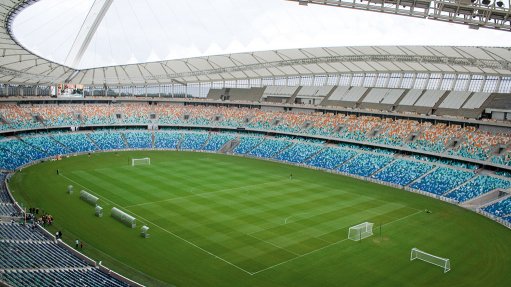
Moses Mabhida Stadium
Photo by: Duane Daws
The eThekwini municipality will invest R8.7-million in the installation of solar photovoltaic (PV) panels at the Moses Mabhida stadium, uShaka Marine World, Kings Park swimming pool, the metro police headquarters, eThekwini Water and Sanitation’s (EWS’s) customer service block and Loram House, home to Durban’s strategic projects unit.
Aluwani Ramulifho, the recently appointed renewables manager at the eThekwini municipality’s energy office, says the locations have been strategically selected to raise the profile of solar energy in the city and represent different size installations.
Panels placed on the arch and above the restaurant at the stadium are expected to generate 112 kW, while the panels at uShaka Marine World will add a further 135 kW and those at the metro police headquarters another 115 kW of power to the city’s grid. Panels on the roof of the Kings Park swimming pool will supply 110 kW, the EWS 45 kW and Loram House 5 kW of electricity.
Ramulifho was speaking at an event entitled Preparing Durban for a Solar PV Future, hosted by the municipality’s energy office and electricity department, as well as the British High Commission and the KwaZulu-Natal Sustainable Energy Forum, at the University of KwaZulu-Natal.
The municipality also recently launched its Durban Solar Map, making it the first city in South Africa to provide an online means of calculating the costs and viability of installing solar panels on buildings across the city.
“We have created the Durban Solar Map so that Durban residents can get a quick estimate of the likely costs of a solar PV installation, as well as an approximation of likely savings,” said Susanna Godehart, the international energy transaction officer at the energy office, who demonstrated the process at the event.
Residents and businesses using the website can type in their addresses and, once the map has zoomed in on the specific location, identify the roof area where they would like to install PV panels. The site calculates the size, potential electricity output and cost of an installation at the defined area.
Another tool developed by the eThekwini municipality that was unveiled is a more comprehensive calculator of solar PV installation costs aimed at installers based in Durban.
These form part of the Durban Solar City Framework, which was compiled with the assistance of Camco Clean Energy. The company was awarded £50 000 by the British High Commission to work with the eThekwini municipality to help address challenges in implementing a large-scale solar PV roll-out in the city.
“Large-scale PV is here – small-scale PV is on its way,” Jonathan Curren of Camco Clean Energy says. He cautiones that there is still a long way to go in addressing the energy crisis in South Africa, emphasising that solar is just one of a mix of technologies required.
Curren highlights a February 2015 National Energy Regulator of South Africa (Nersa) paper, entitled ‘Small Scale Embedded Generation: Regulatory Rules’, detailing how this national approach will open the door to the mass roll-out of embedded generation, specifically for system sizes between 100 kW and 1 MW. This will have a significant impact on enterprise development and job creation, he says.
He joins Godehart and Sanjeeth Sewchurran of the city’s electricity department in highlighting the fact that 95% of the city’s current solar PV installations are illegal both in technical and town planning terms.
Sewchurran says that, despite the fact that the municipality, as a distributor of electricity bought from Eskom, stands to lose revenue from the widespread adoption of solar power, it encourages the introduction of renewable energy. He also notes problems posed by complicated application processes and says that attempts have been made to significantly simplify this process.
More intricate administrative challenges still exist, he acknowledges. In the case of small-scale generation, he says, the municipality has elected to offer remuneration based on a net tariff structure as it is the most practical and easy to administer. In the lead-up to adopting this, he says, eThekwini Electricity has engaged with a number of key stakeholders.
The embedded generation tariff has been submitted to Nersa for approval. In the interim, to prevent delays, he says, the municipality has allowed customers to synchronise to the grid using a policy of zero remuneration as long as all safety and technical criteria are met.
For medium- to large-scale projects, the municipality has opted to buy electricity from embedded generators at the equivalent of avoided purchase costs – the Eskom 275 kV megaflex rate paid by the municipality when buying bulk electricity from Eskom.
According to Sewchurran, eThekwini municipality has concluded power purchase agreements with five local organisations and is in the process of finalising a sixth one. Two of these organisations produce electricity through solar PV installations.